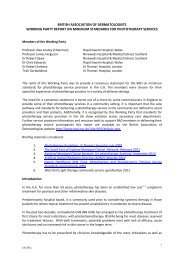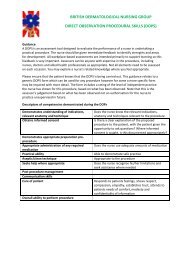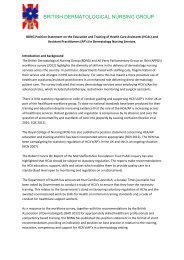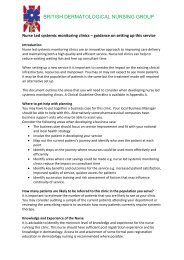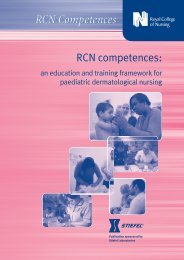Improving outcomes for people with skin tumours including melanoma
Improving outcomes for people with skin tumours including melanoma
Improving outcomes for people with skin tumours including melanoma
You also want an ePaper? Increase the reach of your titles
YUMPU automatically turns print PDFs into web optimized ePapers that Google loves.
For patients <strong>with</strong> low-risk BCC or SCC the majority of recurrences<br />
can be cured if identified early. In addition, patients <strong>with</strong> low-risk<br />
BCC or SCC are at low risk of recurrence and extremely low risk of<br />
mortality, and the majority of these patients will be suitable<br />
candidates <strong>for</strong> self-follow-up. Clinicians should be aware that,<br />
because of their mental or physical state, not all patients will be able<br />
to per<strong>for</strong>m self-examination.<br />
<strong>Improving</strong> Outcomes <strong>for</strong><br />
People <strong>with</strong> Skin Tumours<br />
<strong>including</strong> Melanoma<br />
Follow-up<br />
Ideally, RCTs of the effectiveness of prolonged follow-up should be<br />
the gold standard against which decisions on follow-up strategy are<br />
made. In the absence of these, the factors that need to be taken into<br />
account are:<br />
• the risk of recurrence or development of metachronous (new<br />
primary) disease<br />
• whether there is any evidence that clinicians detect recurrent or<br />
metachronous disease at an earlier stage than patients, whether<br />
treatment of this earlier stage disease is more effective, and<br />
whether patients can be trained to detect recurrence or new<br />
disease as well as doctors.<br />
Follow-up of <strong>skin</strong> cancer patients accounts <strong>for</strong> a significant<br />
proportion of outpatient clinic time. The main aims of follow-up are<br />
different in the immediate post-treatment phase and in the longer<br />
term. Short-term follow-up (less than 6 months) is important <strong>for</strong>:<br />
5<br />
• patient education, especially regarding sun protection measures<br />
and early recognition of new and recurrent lesions<br />
• provision of help, and rehabilitation <strong>for</strong> patients suffering from<br />
complications and side-effects of treatment, e.g. scars,<br />
lymphoedema<br />
• provision of psychological and emotional support to patient,<br />
carer and family<br />
• the evaluation of surgical outcome through audit.<br />
Long-term follow-up (more than 6 months) is usually aimed at:<br />
• identifying locoregional or distant recurrence<br />
• identifying metachronous disease.<br />
Guidance on cancer services: <strong>skin</strong> <strong>tumours</strong> <strong>including</strong> <strong>melanoma</strong><br />
103




